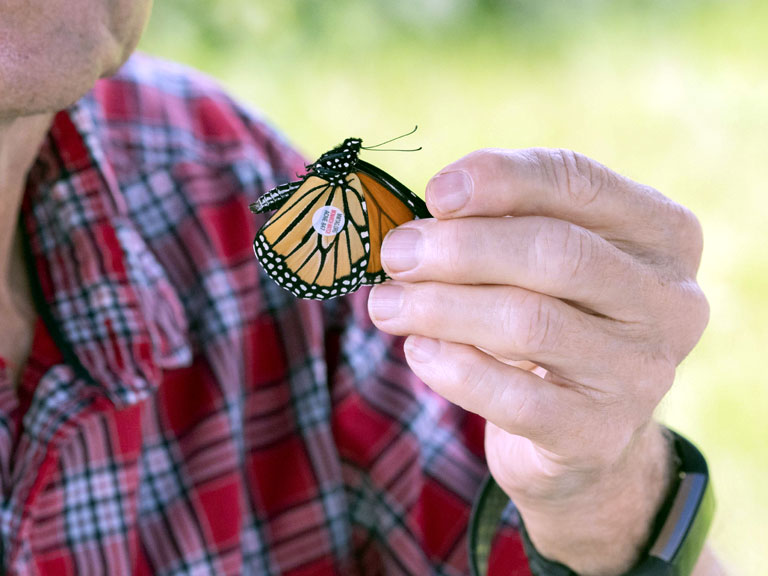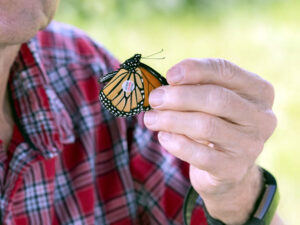County News
Flight of the monarch

Plight of iconic insect is focus of national event
Monarch butterflies typically have a life span of about 30 days. Yet something quite remarkable happens to the monarchs that emerge from their chrysalis in the late summer months. Instead of the drive to reproduce, they are imbued with the need to migrate on a 4,000-kilometre journey to their wintering areas in Mexico where, finally, their reproductive instincts are rekindled. The actual migration pattern and lifecycle of this strikingly coloured insect remained shrouded in mystery until the 1970s, when a tagging project started by Dr. Fred Urquhart and carried out by hundreds of volunteers finally bore fruit. A monarch tagged in Ontario was recovered in Mexico, and this helped to unmask the mystery of these delicate but hardy creatures. One of those early citizen scientists involved in the tagging project was Don Davis. He grew on a farm near Colborne and developed a love for nature early in life. He enrolled in the tagging effort and submitted that as an entry to a regional high school science fair, where he came in second place, narrowly missing out on a trip to Vancouver that was given to the first place finisher. He took a break from tagging during his university years and at the start of his work career, taking it up again in 1985. At that point, he was invited to start a fall outreach program at Presqu’ile in conjunction with the bird banding event called “Monarchs and Migrants Weekend.” Since then he has tagged more than 27,000 monarch butterflies, and he demonstrated the tagging process on Saturday at the second annual Monarch Day at the Hudgin House on Ostrander Point Road on the County’s south shore. The “tag” is a small, numbered adhesive disk— weighing about one-fortieth the weight of the butterfly—that is affixed to the wing close to the insect’s body. The tag number and release location is recorded to a database, so that the origin of the butterfly can be determined if it is recovered at its destination or along the route. For this demonstration, Davis had collected 164 monarchs from a meadow near Cobourg and stored them in a cooler, each encased in an envelope similar to what stamp collectors use. The low temperature kept them in a state of near hibernation, and the insects showed no signs of hesitation upon release after tagging. “It’s been fun,” Davis said of his tagging experience. “I’ve travelled places, been involved in productions of movies and films, such as the IMAX movie Flight of the Butterfly. I’ve been to Mexico three or four times, and to California.” He said it’s important to monitor the health of this butterfly species as a way of discovering changes to the environment. “We really need to look closely at nature and loss of habitat and decline of species. I think we’re in a lot of trouble. I’m not seeing the numbers of insects and butterflies that I used to see. We depend on insects for pollination and as food for animals higher up in the food chain. We’ve got to restore habitat, or allow areas of land to be used as habitat.” He added that events such as Monarch Day are important for sharing knowledge and fostering enthusiasm, especially among the younger generation. “Children and adolescents really get involved, and somebody will pick up an interest and maybe go on to make a career.”

Citizen scientist Don Davis holds a monarch butterfly with a numbered tag affixed to its wing.
The event was organized by the South Shore Joint Initiative (SSJI) and included a series of displays and information booths. Cheryl Chapman offered an educational monarch kit as part of the GET OUT! Kids’ Club. The informative kit offered instructions on how to make a monarch lifecycle diorama, an origami butterfly, a pipe-cleaner monarch caterpillar and a kite. Parents can obtain one of these kits by sending an email to naturehood@peptbo.ca. There was also a representative from Nature Conservancy Canada, which has taken over stewardship of the Hudgin-Rose property as part of conservation efforts to preserve habitat along the south shore. Cheryl Anderson was there representing the SSJI. She led discovery walks through a milkweed meadow, looking for butterfly eggs and monarch caterpillars, as well as having butterfly T-shirts for sale as a fundraiser. She noted that there were far more butterflies visible this year than at the inaugural event last year, when the spell of hot dry weather turned meadows into sere landscapes and monarchs were conspicuous by their absence. “As we know, monarch populations have been down, but happily they seem to be coming back now, and if we bring more awareness to people about monarchs, then perhaps they won’t pull up the milkweed in their gardens and instead leave them there, because monarch caterpillars need the milkweed plants to eat.”
The event was held at the Hudgin house, on which restoration work will start in late September. By coincidence one of the contractors is a direct descendant of Moses Hudgin, who built the house in the 1860s.

Comments (0)